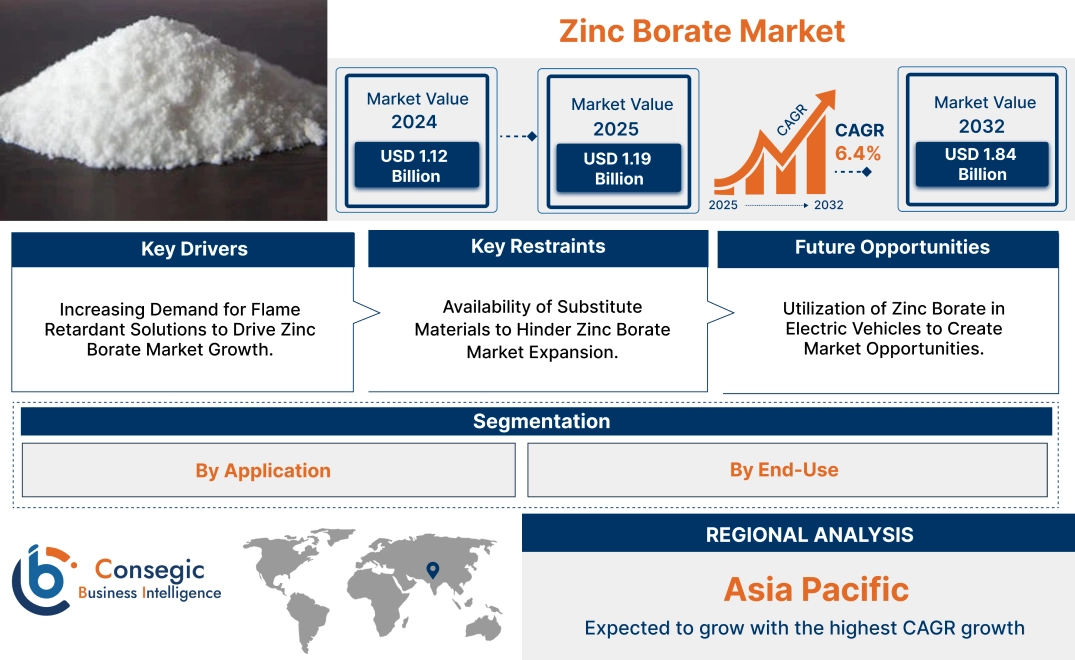Zinc Borate Market Size:
The Zinc Borate Market size is growing with a CAGR of 6.4% during the forecast period (2025-2032), and the market is projected to be valued at USD 1.84 Billion by 2032 from USD 1.12 Billion in 2024. Additionally, the market value for 2025 is attributed to USD 1.19 Billion.
Zinc Borate Market Scope & Overview:
Zinc borate refers to the inorganic compounds containing zinc and borate. It appears as a white crystalline powder with variable chemical compositions, represented as 2ZnO·3B₂O₃·3.5H₂O or with a general formula indicating different zinc and boron ratios and hydration levels. The compound finds significant application across diverse sectors such as construction, automotive, electronics, and packaging among others due to its multi-functional properties. Market analysis indicates a growing demand for zinc borate primarily as a flame retardant and smoke suppressant in plastics and polymers. Its usage extends to paints and coatings for enhanced fire resistance, adhesives and sealants for specialized applications, and paper and textile processing to meet flammability standards. This broad applicability positions zinc borate as a crucial additive in enhancing the safety and performance of numerous end-use products.
How is AI Transforming the Zinc Borate Market?
AI is increasingly being used in the zinc borate market, particularly for optimizing production processes and quality control through automation. AI-powered systems can be used to optimize synthesis processes to achieve high-quality zinc borate. Moreover, AI-driven systems can identify and analyze deviations from optimum parameters, in turn ensuring consistent production of zinc borate with the desired characteristics. In addition, AI-powered automation reduces human error in material handling and production, thereby streamlining complex procedures. Therefore, the aforementioned factors are expected to positively impact the market growth in upcoming years.
Zinc Borate Market Dynamics - (DRO) :
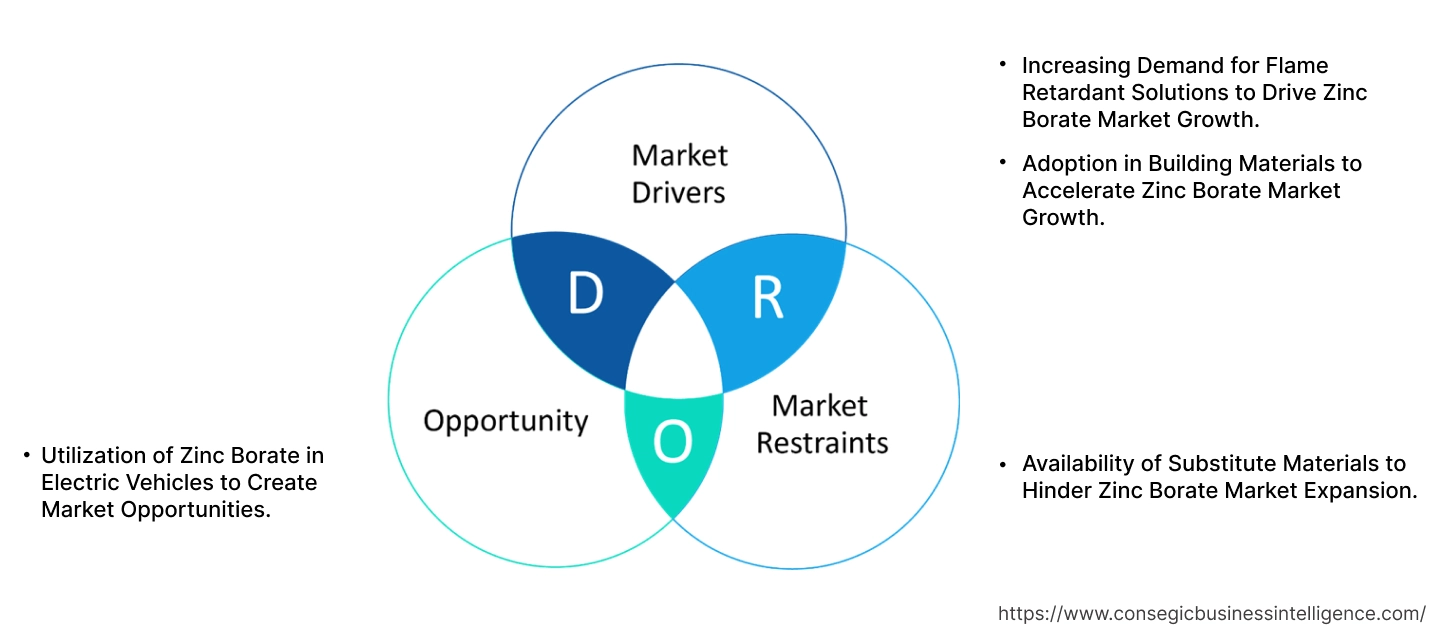
Key Drivers:
Increasing Demand for Flame Retardant Solutions to Drive Zinc Borate Market Growth.
Zinc borate's versatility as a flame retardant drives its widespread use across numerous sectors. In rubbers and plastics for automotive and electronics, it enhances fire resistance. It's crucial in intumescent coatings for construction and in fire-resistant adhesives. Paper and textiles also benefit from the compound’s flame-retardant properties. Governments and regulatory bodies worldwide are continuously implementing and strengthening fire safety standards across numerous sectors. Additionally, the growing incidents of fires supports the adoption of flame retardant materials.
- For instance, according to the Fire and Rescue Incident Statistics: England, published by the Government of the UK, FRSs attended 577,053 fire incidents in the year ending March 2022, an 11% increase compared with the previous year.
Thus, the growing necessity for flame retardants is driving the market revenue.
Adoption in Building Materials to Accelerate Zinc Borate Market Growth.
Zinc Borate serves a fundamental role in building materials as a flame retardant in PVC and thermoplastics as wells as in intumescent coatings for structural protection. It also enhances wood preservation, providing fire and pest resistance. Additionally, it improves fire safety in adhesives, sealants, and gypsum boards. Governments worldwide are increasingly enforcing stricter fire safety standards for all types of buildings, necessitating the use of effective flame retardants like zinc borate.
- For instance, the Fire Safety (England) Regulations 2022, which took effect in January 2023, introduced new mandatory checks for fire doors in multi-occupied residential buildings. According to the Fire Safety Act 2021, flat entrance doors are now explicitly part of the Fire Risk Assessment under the Fire Safety Order.
Thus, as per the market analysis, the increasing requirement for this compound in building materials is contributing to the market revenue.
Key Restraints:
Availability of Substitute Materials to Hinder Zinc Borate Market Expansion.
The market for zinc borate faces a constraint in its growth due to the widespread availability and established use of substitute materials across its various applications. Compound faces competition with a range of other compound capable of fulfilling similar functions. Halogenated flame retardants exhibit high effectiveness in particular polymer systems. Aluminum hydroxide and magnesium hydroxide serve as high-volume, non-halogenated alternatives, especially in applications where higher loading levels are permissible. Phosphorus-based flame retardants demonstrate strong flame-retardant capabilities in specific polymers and textile applications. This abundance of readily available and competitively priced alternatives fosters a competitive environment, encouraging manufacturers to adopt these substitutes. As a result, the above-mentioned factors are limiting the zinc borate market expansion.
Future Opportunities :
Utilization of Zinc Borate in Electric Vehicles to Create Market Opportunities.
The growing adoption of electric vehicle (EV) presents a significant opportunity for zinc borate utilization. Its applications within EVs are diverse, ranging from enhancing the flame retardancy of polymer components in the vehicle's structure and interior to improving the fire resistance of wire and cable insulation within high-voltage systems. The compound is being implemented in battery enclosures and thermal interface materials to address the critical concerns of thermal runaway and overall battery safety. This demand is fueled by stringent safety regulations specific to EVs, the inherent risks associated with lithium-ion batteries, and the industry's drive for lightweighting all supporting with the exponential growth in EV production worldwide.
- For instance, according to IBEF, India's Battery Electric Vehicle (BEV) production is projected to surge, nearly tripling from 130,000 units in 2024 to an estimated 377,000 units in 2025.
As a result, this adoption in electric vehicles benefits the zinc borate market demand.
Zinc Borate Market Segmental Analysis :
By Application:
Based on application, the market is categorized into rubber & plastics, paint & coatings, adhesive & sealants, paper processing agents, textile processing, and others.
Trends in the Application:
- Increasing demand for halogen-free flame retardants is driving the adoption of zinc borate as a safer alternative in plastics.
- Development of nano-zinc borate for improved dispersion and performance in advanced coating formulations.
The rubber & plastics segment accounted for the largest zinc borate market share of 34.11% in 2024.
- Zinc borates exhibit versatility by being utilized as additives across a wide array of polymer types, including PVC, polyamide (nylon), polyolefin, epoxy, acrylics, phenolics, silicones, polyether sulfones, and various elastomers.
- It acts as a potent flame retardant by inhibiting combustion, promoting char formation, minimizing dripping, and suppressing afterglow.
- It finds applications in critical sectors adopting rubber and plastics such as automotive, electronics, construction, aerospace among others.
- The increase in plastic consumption across these sectors increases the requirement for this compound.
- For instance, according to the American Chemistry Council, Inc., EVs use about 45% more plastic than fuel cars. Vehicle chemistry value is up 31% in a decade, with plastics and polymers increasing 18%, making up 10% of weight but 50% of volume, aiding fuel efficiency.
- As a result, aforementioned factors make the rubber & plastics segment dominant in the market.
The others segment is expected to grow at the fastest CAGR over the forecast period.
- The others application segment within the market represents a collection of more specialized uses across a diverse range of sectors.
- In wood preservation, zinc borate combats fungi and pests, extending product life. It acts as a fluxing agent in specific ceramic and glass manufacturing. Agriculture utilizes it as a vital micronutrient and fungicide.
- The compound also functions as an arc suppressor in electrical plastics, and an additive in lubricants and scintillation compounds. Furthermore, it serves as a bonding agent for materials like aluminum foil and fiberglass.
- Growing need for wood preservation, driven by sustainability and regulations, presents significant adoption of the compound. Increasing agricultural awareness of micronutrients and fungicides boosts its use.
- Hence, owing to the above-mentioned analysis, the others segment is expected to grow at the fastest rate over the future years, creating zinc borate market opportunities.
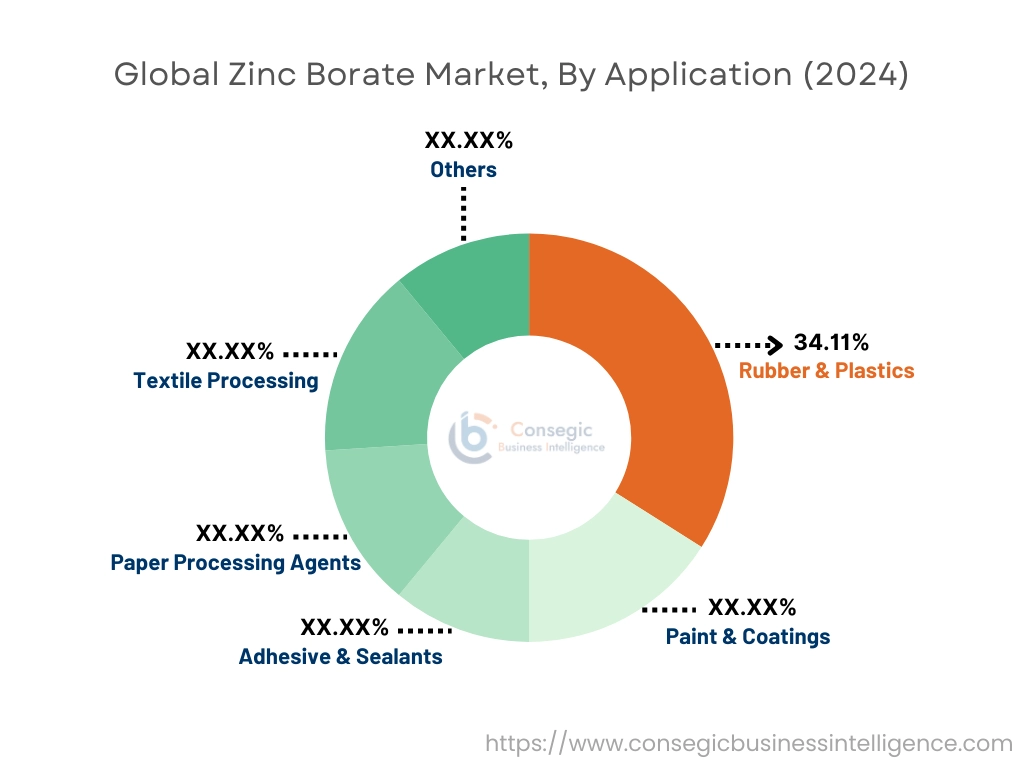
By End-Use:
The end use segment is categorized into automotive & transportation, electronics, construction, consumer goods, packaging, textiles, and others.
Trends in the End Use:
- Growing use of zinc borate in electric vehicles for battery housings and thermal management applications requiring enhanced fire safety.
- Increasing use of zinc borate in fire-retardant coatings and insulation materials to comply with stricter building codes and safety standards.
The construction segment accounted for the zinc borate market share in 2024.
- The construction sector is a major consumer of zinc borate, primarily focused on enhancing fire safety, durability, and providing protective properties to various building materials.
- It acts as a flame retardant in PVC and other polymers, a smoke suppressant, and a key component in intumescent coatings for structural protection.
- Its role in wood preservation aligns with sustainability trends, resisting fire, decay, and pests. Stringent building codes, growing fire hazard awareness, drive its adoption.
- Moreover, the need for durable, energy-efficient materials supports the compound's importance in the expanding global construction sector.
- Thus, as per the zinc borate market analysis, the construction segment is dominating the zinc borate market trends.
The automotive & transportation segment is expected to grow at the fastest CAGR over the forecast period.
- The automotive & transportation end-use sectors segment within the market is projected to exhibit the most rapid growth rate as zinc borate plays a crucial role in enhancing the safety and durability of various components.
- Its applications span interior components, wire harnesses, rubber parts, and even fire-resistant adhesives. The automotive industry's focus on lightweighting through increased use of plastics and composites further fuels demand for the compound as a vital flame retardant.
- For instance, according to S. Department of Energy, reducing vehicle weight by 10% improves fuel economy by 6%-8%. Lightweight materials are capable of cutting body/chassis weight by 50%, lowering fuel use.
- Notably, the growing electric vehicle market presents significant potential for the compound in battery housings and thermal management.
- Hence, the continuous innovation within electronic vehicles positions the automotive & transportation sector as significant growth for consumption in the forecast period.
Regional Analysis:
The regional segment includes North America, Europe, Asia Pacific, the Middle East and Africa, and Latin America.
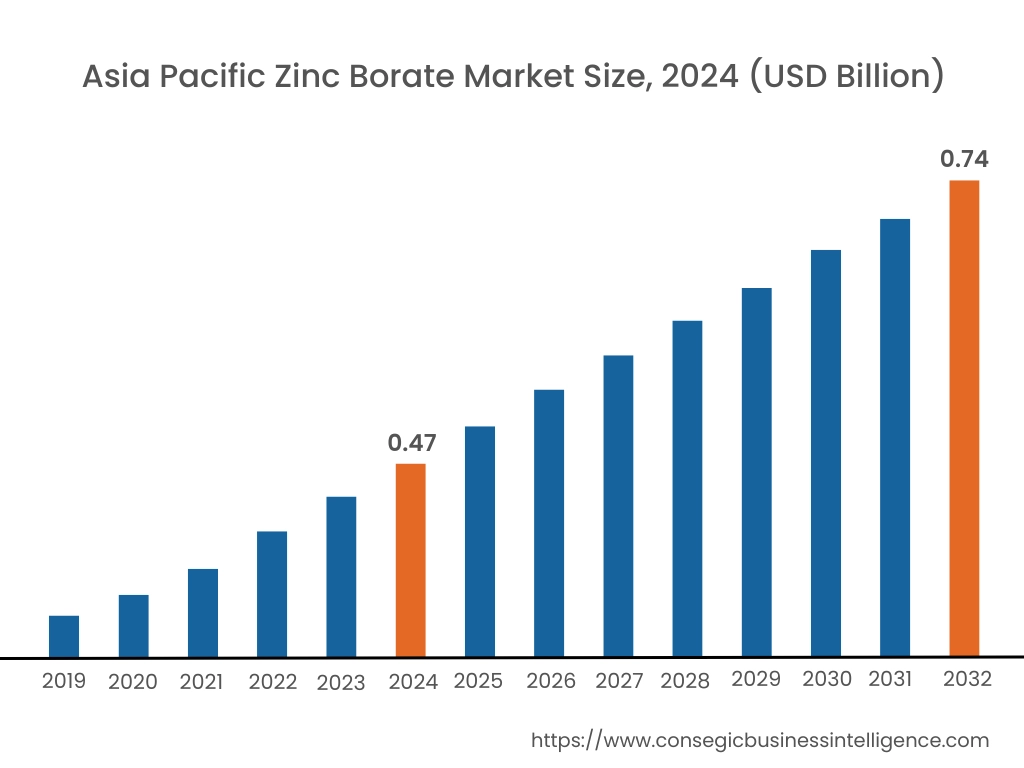
In 2024, Asia Pacific accounted for the highest market share at 42.34% and was valued at USD 0.47 Billion and is expected to reach USD 0.74 Billion in 2032. In Asia Pacific, the China accounted for a market share of 38.02% during the base year of 2024. Asia Pacific’s influence on the market is significant due to the region being the dominant consumer of this compound for rubber and plastic production. Asia Pacific is the global manufacturing hub for a vast array of plastic products, ranging from consumer goods and packaging to automotive components and electronics. These nations are experiencing significant expansion in sectors such as construction, automotive, and electronics, which are major consumers of flame-retardant substances like zinc borate.
- For instance, according to the China Briefing, in 2024, electronic information manufacturing sector in China experienced an 11.8% increase in value-added output year-on-year.
The presence of major manufacturers and the easy availability of raw materials solidifies Asia Pacific’s significant influence on the overall market.
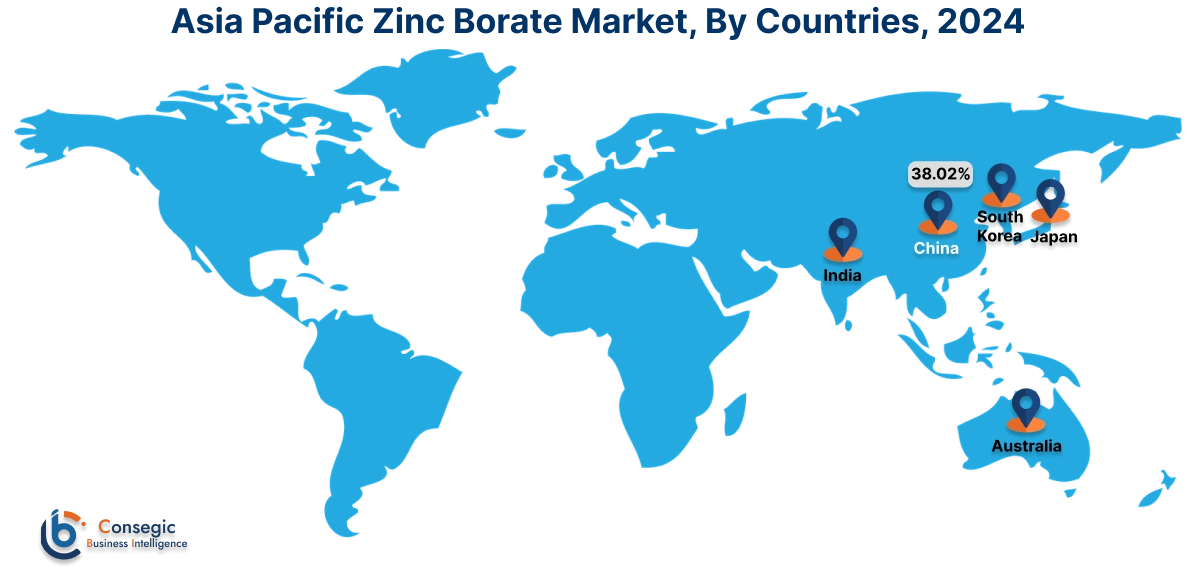
In Europe, the zinc borate market demand is experiencing the fastest growth with a CAGR of 7.8% over the forecast period. The region is experiencing significant growth, driven by strong emphasis on innovation, regulatory compliance, and sustainable development. Key countries such as Germany, France, and Italy, with their robust manufacturing and automotive sectors, contribute significantly to this requirement. Stringent fire safety regulations across various sectors, coupled with an increasing preference for environmentally friendly flame retardants support market revenue. Furthermore, the European Union's focus on low-emission technologies and circular economy practices creates a favorable environment for the adoption of the compound in EV. These factors collectively present a positive impact on the share of European market analysis.
The North America market trend is significantly defined by strong emphasis on safety regulations, particularly within the construction and automotive sectors. The increasing focus on stringent fire safety standards in both residential and commercial buildings necessitates the use of effective flame retardants such as zinc borate in various construction materials, including PVC, intumescent coatings, and wood preservation. Furthermore, the well-established automotive sector in North America utilizes these compounds in interior components and wiring to meet flammability requirements and support lightweighting trends. These factors position North America as a significant and growing market for the compound.
The Latin American Zinc Borate market trend is driven by the region's focus on infrastructure development. The growing investments in manufacturing sectors, particularly in countries such as Brazil are leading to higher consumption in consumer goods and construction sectors. The increasing adoption of high-performance adhesives and coatings is also expected to contribute to the market growth in this region. Furthermore, the expanding paper and packaging sectors in some Latin American countries are expected to boost the requirement for the compound. Hence, as per analysis, these aforementioned factors are creating zinc borate market opportunities in the region.
The Middle East and African Zinc Borate market analysis is currently characterized by increasing investments in infrastructure development trend and industrial growth across the region, leading to higher requirements for the flame retardants. Increasing construction activities and a rising awareness of fire safety regulations across various sectors are also supporting market. Additionally, the developing manufacturing sector in several MEA countries is expected to boost the consumption of the compound in adhesives, paints, and coatings applications.
Top Key Players and Market Share Insights:
The Global Zinc Borate Market is highly competitive with major players providing products to the national and international markets. Key players are adopting several strategies in research and development (R&D) and product innovation to hold a strong position in the global Zinc Borate market. Key players in the Zinc Borate industry include
- Rio Tinto (United Kingdom)
- Qingdao Pengfeng New Material Technology Co., Ltd. (China)
- SHANDONG WUWEI FLAME RETARDANT SCI.&TECH. CO.,LTD (China)
- APCO MINERAL INDUSTRIES (India)
- Shandong Elite Chemicals Co., Ltd. (China)
- Royce Global (U.S.)
- Akdeniz Chemson (Germany)
- Eti Maden (Turkey)
- SCL Italia S.p.A. (Italy)
- Wallace FR Ltd (United Kingdom)
Zinc Borate Market Report Insights:
| Report Attributes | Report Details |
| Study Timeline | 2019-2032 |
| Market Size in 2032 | USD 1.84 Billion |
| CAGR (2025-2032) | 6.4% |
| By Application |
|
| By End-Use |
|
| By Region |
|
| Key Players |
|
| North America | U.S. Canada Mexico |
| Europe | U.K. Germany France Spain Italy Russia Benelux Rest of Europe |
| APAC | China South Korea Japan India Australia ASEAN Rest of Asia-Pacific |
| Middle East and Africa | GCC Turkey South Africa Rest of MEA |
| LATAM | Brazil Argentina Chile Rest of LATAM |
| Report Coverage |
|
Key Questions Answered in the Report
How big is the Zinc Borate market? +
In 2024, the Zinc Borate market is USD 1.12 Billion.
Which is the fastest-growing region in the Zinc Borate market? +
Europe is the fastest-growing region in the Zinc Borate market.
What specific segmentation details are covered in the Zinc Borate market? +
By Application and End Use segmentation details are covered in the Zinc Borate market.
Who are the major players in the Zinc Borate market? +
Rio Tinto (United Kingdom), Royce Global (U.S.), Akdeniz Chemson (Germany), Eti Maden (Turkey) are some of the major players in the market.
